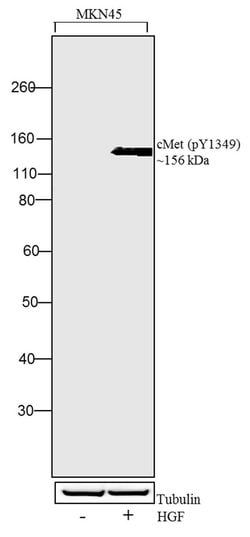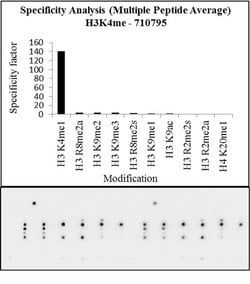Phospho-c-Met (Tyr1349) Recombinant Polyclonal Antibody (15HCLC), Invitrogen™
Manufacturer: Thermo Scientific
Select a Size
| Pack Size | SKU | Availability | Price |
|---|---|---|---|
| Each of 1 | 71-079-2-Each-of-1 | In Stock | ₹ 52,955.00 |
71-079-2 - Each of 1
In Stock
Quantity
1
Base Price: ₹ 52,955.00
GST (18%): ₹ 9,531.90
Total Price: ₹ 62,486.90
Antigen
Phospho-c-Met (Tyr1349)
Classification
Recombinant Polyclonal
Concentration
0.5 mg/mL
Formulation
PBS with 0.09% sodium azide; pH 7.2
Gene Accession No.
P08581
Gene Symbols
MET
Immunogen
Phosphorylated peptide corresponding to Human MET (aa 1346-1352)
Quantity
100 μg
Primary or Secondary
Primary
Target Species
Human
Product Type
Antibody
Isotype
IgG
Applications
Immunocytochemistry, Western Blot
Clone
15HCLC
Conjugate
Unconjugated
Gene
MET
Gene Alias
AI838057; AUTS9; bHLHe59; CG1705; CG1705-PA; CG1705-PB; cmet; c-met; c-met proto-oncogene; c-Met receptor tyrosine kinase; c-Met/HGF receptor; D249; DFNB97; Dmel\CG1705; Dmel_CG1705; DmMet; EC 2.7.10.1; Hepatocyte growth factor receptor; HGF; HGF receptor; HGF receptor c-Met; HGF/SF receptor; HGFR; HGF-SF receptor; juvenile hormone resistance; met; met proto-oncogene; met proto-oncogene (hepatocyte growth factor receptor); met proto-oncogene tyrosine kinase; MET proto-oncogene, receptor tyrosine kinase; Met/Met1; Met; protein tyrosin kinase; methoprene tolerant; Methoprene-tolerant; Methoprene-tolerant protein; Met-PA; Met-PB; Mett; oncogene MET; Par4; Proto-oncogene c-Met; RCCP2; resistance (1) juvenile H; resistance to juvenile hormone; Rst(1)JH; sc MET; scatter factor receptor; SF receptor; soluble c met; tyrosine-protein kinase Met
Host Species
Rabbit
Purification Method
Protein A
Regulatory Status
RUO
Gene ID (Entrez)
4233
Content And Storage
Store at 4°C short term. For long term storage, store at -20°C, avoiding freeze/thaw cycles.
Form
Liquid
Description
- This antibody is predicted to react with Monkey, Horse, Pig, Bovine, Feline, Goat, Rat and Mouse
- Recombinant rabbit polyclonal antibodies are unique offerings from Thermo Fisher Scientific
- They are comprised of a selection of multiple different recombinant monoclonal antibodies, providing the best of both worlds - the sensitivity of polyclonal antibodies with the specificity of monoclonal antibodies - all delivered with the consistency only found in a recombinant antibody
- While functionally the same as a polyclonal antibody - recognizing multiple epitope sites on the target and producing higher detection sensitivity for low abundance targets - a recombinant rabbit polyclonal antibody has a known mixture of light and heavy chains
- The exact population can be produced in every lot, circumventing the biological variability typically associated with polyclonal antibody production
- MET (cMET) is a receptor-like tyrosine kinase whose dysregulation has been linked to many types of human malignancies
- After activation of the ligand, MET interacts with the PI3-kinase subunit PIK3R1, PLCG1, SRC, GRB2, and STAT3
- There interactions lead to the activation of signaling cascades including RAS-ERK, PI3, kinase-AKT, and PLCgamma-PKC
- MET plays a role in embryonic development including gastrulation, development of muscles and neurons, angiogenesis, and kidney formation
- It also plays a role in adults including wound healing, organ regeneration, and tissue remodeling
- MET has been linked to cancers including gastric, renal, and breast; therefore, making it a target for cancer therapeutics and diagnostic testing.



